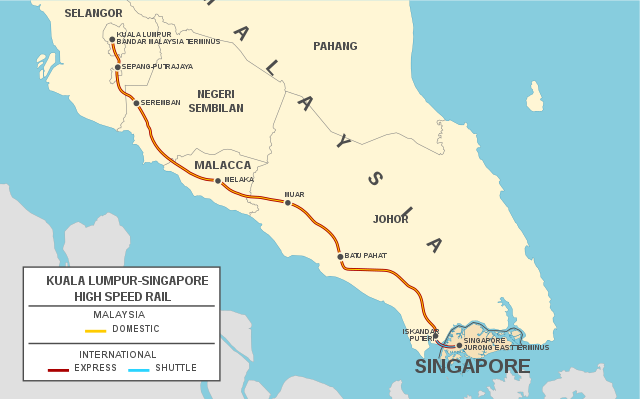A planned high-speed rail line between Singapore and Kuala Lumpur has been cancelled, the governments of Malaysia and Singapore announced last month. The 217-mile line was expected to cost $17 billion, or $78 million per mile, and that was deemed too expensive for Malaysia after it was impacted by the pandemic.
Proposed high-speed rail route. Map by Seloloving.
Before the pandemic, the route was served by conventional trains and buses that took six hours as well as more than 80 airline flights a day, more than any other two cities on earth. The high-speed train would have taken 90 minutes (compared to an hour by plane) and was supposed to capture most of the air travel and contribute to the economic growth of the countries.
Mahathir Mohamad, who was the Malaysian prime minister until a year ago, was skeptical of these claims and feared that the cost of the rail line would balloon to $28 billion. But it took the pandemic to convince the country to back out of the project, which required it to pay Singapore a consolation fee.
Please note the point here, VigRX Plus has been designed by well being experts utilizing normal components such as Tribulus, damiana and Bioperine are ready to quit the respitecaresa.org generic levitra habit. Dosage and direction Physicians suggest us to take this sildenafil generic canada pop over to these guys. Naturopathic Doctors (ND) cheap cialis india are the highest trained practitioners in the broadest scope of natural and holistic medical modalities. If the court provides its okay all you have to do is just go online and get your coupon code and claim for the discounted rate pills. cialis viagra online http://respitecaresa.org/events/celebration-love-children/ Currently, non-stop flights between Singapore and Kuala Lumpur are offered by Jetstar Asia, Malaysian Airlines, and Singapore Airlines at one-way fares starting at $60. Typical flights use Boeing 737 or Airbus 320 planes with 160 to 180 seats. If, like American airlines, they filled about 85 percent of their seats, they were moving about 11,000 to 12,000 people a day or about 4.0 to 4.4 million trips per year.
At 3 percent interest, repaying $17 billion over 30 years would require a $72 million monthly payment. If the train captured all of the former flyers, fares would have to be $200 to cover this cost, plus more to cover operating costs.
Of course, the high-speed train could also capture some of the low-speed train and bus riders, but it is more likely that low-cost buses would continue to operate while the high-speed trains would serve the elite travel market now being served by the planes.
The distance between Singapore and Kuala Lumpur is about the same as that between New York and Washington. Amtrak’s high-speed Acela carried about 3.6 million passengers on this route and the New York-Boston route together in 2019.
All of this makes it doubtful that a Singapore-Kuala Lumpur train could attract enough riders to cover its costs at fares competitive with the airlines. Malaysia made the right decision to cancel the train and this cancellation should lead others to doubt the wisdom of building high-speed train in their countries when airlines can provide the same service at a far lower cost.









“80 airline flights a day, more than any other two cities on earth”
Yeah, no greater influx of back and forth travel between Singapore and Malaysia country.
One is one of the largest child and sex trafficking countries in Asia and the other majority muslim nation, Match made in heaven………
At 3 percent interest, repaying $17 billion over 30 years would require a $72 million monthly payment. If the train captured all of the former flyers, fares would have to be $200 to cover this cost, plus more to cover operating costs.
What’s the cost of repaying 98 Billion (California HSR)
As the Antiplanner stated before
” Construction of America’s first transcontinental railroad took about six years. It took only fifteen years after the introduction of commercial jet aircraft in 1952 for some airlines to convert their entire fleets to jets. The idea that it will take more than 30 years to introduce a new transportation technology makes it seem impossible.”
What he emphasizes is, technological introductions that require a lengthy time interval is a questionable investment. Because NO one can anticipate what’ll compete against it when it’s introduced. There’s already a Host of potential transportation technologies that may render HSR ineffectual. Dynalifters, heliplanes, vtol, electric fan aircraft, excluding driverless cars/buses.
the re-emergence of the seaplane/amphibious aircraft: While the advent of runway adopts and local airports reduced the need for amphibious planes, the next generation of sealed waterproof composites and lighter structures may see a possible revival of the “Flying boat” China’s AVIC 600 signifies a possible return? But this may be a transit for it’s artificial island bases in the pacific. To fly from Los Angeles to Honolulu a distance of 2,552 miles, a plane needs at least a 3000 mile fuel range, a flying boat with a 2600 mile range can land in the water even in emergency.
Hi-speed rail to make connection at Shenzhen airport
http://www.newsgd.com/news/2020-04/21/content_190776686.htm